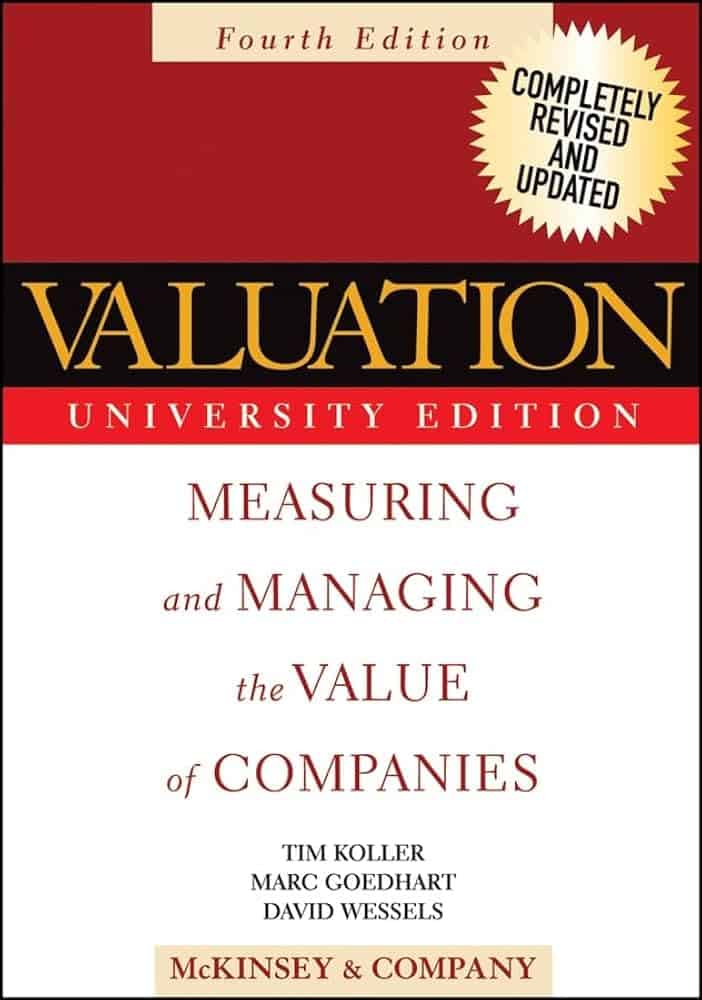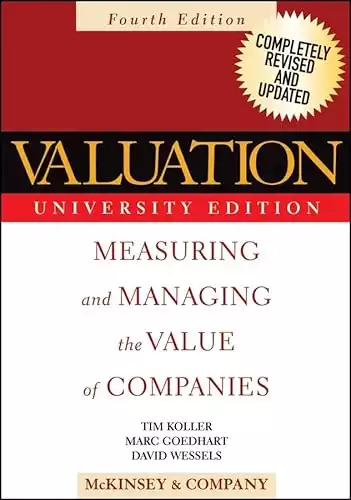Overview : Valuation
- Book Title: Valuation:- Measuring and Managing the Value of Companies
- Author: McKinsey & Company Inc., Tim Koller, Marc Goedhart, and David Wessels
- Publication Date: July 2020 (7th Edition)
- price: $5.99
- Pages: 850
Overview of the Book
This book is authored by Tim Koller, Marc Goedhart, and David Wessels, experts from McKinsey & Company. They specialize in corporate valuation, strategy, and financial analysis, bringing decades of practical and theoretical insights into creating value for companies.
Introduction
In the ever-evolving world of finance and investing, understanding how to accurately value companies is a crucial skill. "Valuation: Measuring and Managing the Value of Companies," now in its seventh edition, continues to be the go-to resource for professionals and students alike. Authored by McKinsey & Company Inc., Tim Koller, Marc Goedhart, and David Wessels, this comprehensive guide offers invaluable insights into the complex world of corporate valuation.
Book Summary
"Valuation" provides a structured framework for assessing company worth, integrating both theoretical principles and practical applications. The book covers a wide range of valuation methodologies, including:
- Discounted Cash Flow (DCF) analysis
- Economic profit models
- Relative valuation techniques
These methodologies are explained in detail, with the authors highlighting the strengths and limitations of each approach. This balanced perspective allows readers to make informed decisions about which valuation method is most appropriate for different scenarios.
Analysis of Themes
Financial Transparency and Reporting
One of the book's central themes is the importance of clear and transparent financial reporting. The authors argue that accurate valuation depends on high-quality financial disclosures, which enable stakeholders to better understand a company's financial health and future prospects. This focus on transparency is particularly relevant in today's market, where investors increasingly demand greater accountability from companies.
Risk Assessment and Market Volatility
In an era of unprecedented market volatility, "Valuation" addresses the challenges of valuing companies in uncertain environments. The book emphasizes the importance of incorporating risk assessments and scenario analysis into the valuation process, providing readers with tools to navigate unpredictable market conditions. This forward-thinking approach is essential for investors and analysts dealing with emerging market trends and potential disruptions like cryptocurrencies.
Strategic Decision-Making
Beyond mere number-crunching, the book explores how valuation insights can inform strategic business decisions. From mergers and acquisitions to capital allocation, the authors demonstrate how a solid understanding of valuation principles can drive better corporate governance and long-term value creation.
Writing Style
The authors strike a balance between academic rigor and practical applicability. While the content can be dense at times, the logical structure and clear explanations make complex concepts accessible to readers with varying levels of financial expertise. Each chapter concludes with summaries and key takeaways, reinforcing the main points and aiding comprehension.
Strengths and Weaknesses
Strengths:
- Comprehensive coverage of valuation methodologies
- Rich in real-world examples and case studies
- Practical tools and resources via companion website
- Strong emphasis on applying theory to practice
Weaknesses:
- Can be challenging for beginners due to its depth and breadth
- Limited coverage of newer financial instruments and technologies
Comparison to Other Works
While "Valuation" stands out for its comprehensive approach, it's worth comparing it to other notable works in the field:
- Investment Valuation" by Aswath Damodaran: Offers a more academic perspective but lacks the practical focus of "Valuation
- The Little Book of Valuation" by Aswath Damodaran: A more accessible introduction to valuation concepts, but not as in-depth
- "Financial Statement Analysis and Security Valuation" by Stephen Penman: Focuses more on financial statement analysis but complements "Valuation" well
Highlights from Valuation: Measuring and Managing the Value of Companies
- Valuation fundamentals: Provides frameworks for assessing the value of companies.
- Discounted cash flow (DCF): Focuses on DCF as a key valuation method.
- Financial statements: Emphasizes the importance of understanding financial reports for valuation.
- Market comparisons: Discusses using industry multiples and peer comparisons.
- Value drivers: Identifies key factors influencing a company's value, such as growth and risk.
- Risk assessment: Highlights the role of risk in determining a company's worth.
- Practical applications: Offers insights for valuing firms in mergers, acquisitions, and investments.
Conclusion
"Valuation: Measuring and Managing the Value of Companies" remains an indispensable resource in the field of corporate finance. Its blend of theoretical rigor and practical insights makes it valuable for a wide range of readers, from seasoned professionals to students of finance. In an era of rapid market changes and evolving financial instruments, the principles outlined in this book provide a solid foundation for understanding and applying valuation techniques.
Key Quotes:
"Understanding a company's value is critical for making informed business decisions." "Transparent reporting is crucial for accurate valuation, as it helps stakeholders better understand a company's financial health and future prospects."
Ready to master the art of company valuation? Get your copy of "Valuation: Measuring and Managing the Value of Companies" today and take your financial analysis skills to the next level. Click here to purchase on Amazon and start your journey towards becoming a valuation expert!





